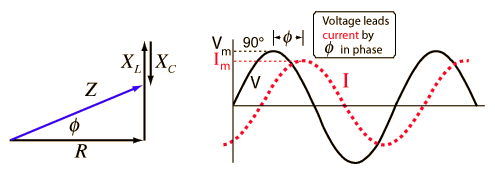AC Ohm's Law
The AC analog to Ohm's law is

where Z is the impedance of the circuit and V and I are the rms or effective values of the voltage and current. Associated with the impedance Z is a phase angle, so that even though Z is the also the ratio of the voltage and current peaks, the peaks of voltage and current do not occur at the same time. The phase angle is necessary to characterize the circuit and allow the calculation of the average power used by the circuit.
 |

The illustration is for a case where the inductive reactance is dominant over the capacitive reactance as shown in the phasor diagram.
Default values will be entered for V and Z above if they are left unspecified, but those values can be changed. If the current is changed, then Z will be recalculated. If a phase angle outside the allowed range -90 to +90 is entered, it will be replaced by a default value.
AC circuit concepts
| HyperPhysics***** Electricity and Magnetism | R Nave |